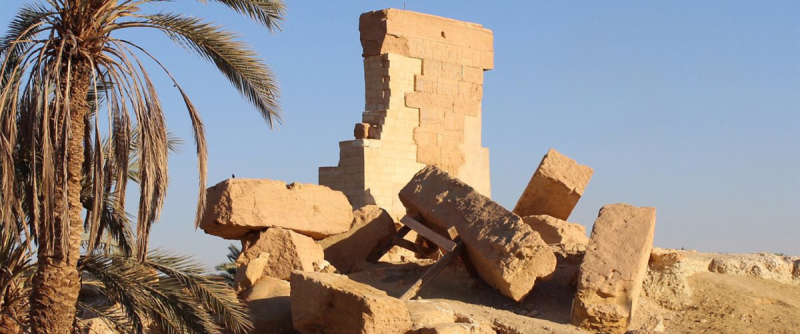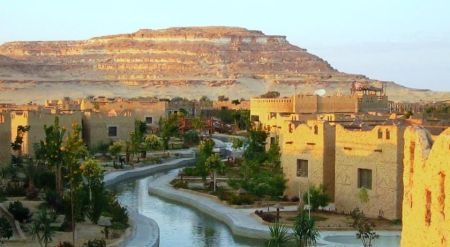Temple of Umm Ubayd

Temple of Umm Ubayd: The Forgotten Gem of Egypt’s Western Desert
Deep in the heart of Egypt’s Western Desert lies a sacred ruin shrouded in mystery — the Temple of Umm Ubayd, also known as the Temple of Umm Ubayda. This ancient sanctuary, tucked near the enchanting Siwa Oasis, stands as a silent witness to millennia of devotion, mythology, and cultural exchange. Carved from limestone and adorned with hieroglyphic fragments, the temple once glorified the Egyptian god Amun, the same deity celebrated in the nearby Oracle of Amun.
The Temple of Umm Ubayd isn’t merely a pile of weathered stones; it’s a symbolic link between Egypt’s Pharaonic traditions and the Greco-Roman influences that later touched this region. Every cracked column and scattered relief tells a story of faith, conquest, and adaptation. Although much of the structure has collapsed, archaeologists and travelers alike are drawn to this enigmatic site for its spiritual aura and historical significance. In a remote corner of the desert, far from Cairo’s bustling streets or the grandeur of the Great Pyramids of Giza, Umm Ubayd reveals another face of Egypt — one both intimate and eternal.
Incorporating the principles of “AIDA” — attention, interest, desire, and action — the Temple of Umm Ubayd sparks intrigue from the moment you lay eyes on its ruins. It captures attention through its desolate beauty, sustains interest through its mythic associations with Amun, evokes desire with its aura of mystery, and calls travelers to action by compelling them to visit and witness a piece of antiquity that still whispers secrets of the divine.
Historical Background of the Temple of Umm Ubayd
The Temple of Umm Ubayd dates back to the reign of Pharaoh Nectanebo II, the last ruler of Egypt’s 30th Dynasty, around the 4th century BCE. Its construction reflected the continued worship of Amun, whom the Siwans revered as their chief deity. The temple once stood connected to the nearby Oracle of Amun, forming a sacred axis through which pharaohs and pilgrims sought divine counsel. Though time and earthquakes shattered much of its architecture, its surviving fragments offer invaluable clues to ancient Egyptian spirituality and desert civilization.
Interestingly, Greek inscriptions found at the site suggest that the temple remained active long after Egypt fell under Greek and later Roman rule. This blend of cultural markers highlights how the Temple of Umm Ubayd became a crossroads of Egyptian tradition and Hellenistic influence. Scholars believe its original walls were once adorned with reliefs depicting Amun’s processions, offerings, and royal dedications — a divine narrative linking the gods of Thebes to the remote western deserts of Siwa.
Architectural Features and Layout of the Temple
Although only partial ruins stand today, researchers have pieced together the temple’s layout through surviving columns, lintels, and foundation stones. The structure followed classical Egyptian design principles, with a pylon entrance leading into a hypostyle hall and sacred sanctuary. The remains of elaborate carvings, once painted in vivid colors, still cling to the weathered stone — faded echoes of ancient ritual art.
Like other temples devoted to Amun, the Temple of Umm Ubayd likely featured an orientation aligned with celestial events, possibly the solstice sunrise. The architectural style hints at a reverence for cosmic balance and divine order, aligning human construction with the rhythms of nature. Visitors today can still trace the outlines of this cosmic geometry amid the golden sands, imagining priests conducting sacred ceremonies beneath the desert sky.
The Religious Significance of Amun in Siwa Oasis
The god Amun reigned supreme at Siwa Oasis, where his oracle once guided kings and generals — even Alexander the Great himself. The Temple of Umm Ubayd served as an extension of this powerful cult, reinforcing Siwa’s role as a spiritual hub. Worshippers sought Amun’s wisdom for matters of governance, fertility, and fate. The temple’s inscriptions and fragments suggest that offerings and prayers were made to ensure the prosperity of both the oasis and its inhabitants.
Spiritual energy still flows through this sacred ground. Travelers often report a profound sense of calm and introspection while standing among the ruins. This magnetic pull, deeply rooted in the legacy of Amun’s worship, makes Umm Ubayd not just an archaeological site but a place of quiet contemplation and connection to Egypt’s ancient soul.
Rediscovery and Archaeological Excavations
The modern rediscovery of the Temple of Umm Ubayd occurred during the 19th century, when European explorers began mapping the Siwa region. Since then, numerous archaeological missions have surveyed the site, cataloging inscriptions and recovering sculptural fragments now preserved in museums. These studies reveal that the temple once formed part of a larger religious complex that included altars, courtyards, and possibly a ceremonial lake used for purification rites.
Despite its deteriorated condition, the site continues to fascinate Egyptologists. Each excavation season uncovers new data about construction methods, iconography, and the late dynastic religious landscape. Comparing Umm Ubayd with other sanctuaries, such as the Temple of Philae or the Karnak Temple, helps scholars trace the diffusion of Amun’s worship across Egypt’s temples and distant oases.
Temple of Umm Ubayd and Siwa’s Cultural Heritage
The Temple of Umm Ubayd stands as an integral part of Siwa’s cultural identity. The oasis, renowned for its Berber traditions, pristine landscapes, and ancient ruins, has preserved a unique blend of Egyptian and North African heritage. For locals, the temple isn’t merely an archaeological relic — it embodies ancestral pride and continuity. The site also complements nearby attractions like Shali Castle and the Mountain of the Dead, forming a tapestry of history and spirituality that draws travelers seeking authenticity.
Efforts to preserve Umm Ubayd are ongoing, with renewed interest from Egypt’s Ministry of Antiquities and international partnerships. Conservation specialists are exploring eco-friendly methods to stabilize the stones while promoting sustainable tourism. Visitors who include Siwa in their Egypt Travel Packages often describe the temple as one of the most profound encounters in their journey — a quiet monument that embodies Egypt’s timeless mystery.
Mythology and Symbolism Surrounding the Temple
Legends woven around the Temple of Umm Ubayd intertwine divine love, prophecy, and cosmic guidance. Local folklore suggests that Amun himself once manifested through the oracle linked to this temple, delivering messages that shaped the destiny of kingdoms. The temple’s presence near the Oracle of Amun underscores its importance as a spiritual satellite, amplifying divine communication.
Symbolically, Umm Ubayd represents the convergence of earth and sky — a meeting point where mortals reached toward the gods. Many carvings discovered at the site depict offerings of lotus flowers, solar disks, and falcons, each carrying layered meanings about rebirth and protection. These motifs resonate with Egypt’s broader mythological themes, echoing the cycles of death and resurrection embodied by Osiris and the sun god Ra.
Visiting the Temple of Umm Ubayd Today
Reaching the Temple of Umm Ubayd feels like a pilgrimage through time. Travelers journey from Marsa Matruh City along desert roads until the vast expanse of Siwa emerges like a mirage. The temple lies just a short distance from Siwa’s main village, accessible by foot or bicycle. The sun-drenched ruins, surrounded by palm groves and salt lakes, make for a scene straight out of an ancient tale.
Tour guides often combine visits to Umm Ubayd with attractions such as Cleopatra’s Spring and the Oracle Temple. Whether you’re fascinated by ancient hieroglyphs, desert landscapes, or spiritual energy, this site promises an unforgettable experience. As the golden sunset casts long shadows over the stones, you can almost hear echoes of priests chanting prayers to Amun, blessing travelers on their journey through the sands.
Travel Tips for Exploring Siwa’s Hidden Temples
When planning a visit to Umm Ubayd, it’s best to include it in a broader desert adventure or cultural itinerary. Specialized Egypt Desert Tours offer guided excursions through Siwa’s dunes, hot springs, and historical ruins. The best time to visit is between October and April, when the weather is mild and the desert air carries a crisp serenity.
For a deeper dive into Egypt’s temple heritage, travelers often continue their journey to southern landmarks like Abu Simbel Temples or the Edfu Temple. Each of these sites reveals another chapter in Egypt’s spiritual evolution, yet few capture the raw intimacy and mystic silence that the Temple of Umm Ubayd offers.
Preservation and Sustainable Tourism
Preserving Umm Ubayd is a delicate task. The sandy winds and temperature fluctuations of the desert threaten its fragile stones. Conservationists are now employing 3D mapping, digital reconstruction, and controlled access to safeguard its integrity. Sustainable tourism initiatives encourage visitors to respect the site by avoiding climbing or touching carvings, ensuring that future generations can still marvel at its beauty.
The temple’s protection is not just an archaeological concern but a cultural one. It symbolizes Egypt’s ongoing effort to balance modernization with heritage preservation — an effort echoed across landmarks like the Grand Egyptian Museum and beyond.
Frequently Asked Questions About the Temple of Umm Ubayd
Where is the Temple of Umm Ubayd located?
The Temple of Umm Ubayd is situated near Siwa Oasis in Egypt’s Western Desert, approximately 750 kilometers southwest of Cairo. It’s part of a series of archaeological sites that include the Oracle of Amun and Shali Fortress.
Who built the Temple of Umm Ubayd?
The temple was commissioned during the reign of Pharaoh Nectanebo II in the 4th century BCE, dedicated to the god Amun. Later, during the Greek and Roman periods, additional modifications were made, blending Egyptian and Hellenistic architectural styles.
What was the purpose of the Temple of Umm Ubayd?
The temple served as a place of worship for Amun and functioned as a complementary sanctuary to the nearby Oracle of Amun. It was used for rituals, offerings, and consultations with the divine.
Can tourists visit the Temple of Umm Ubayd?
Yes, the site is open to visitors. It’s easily accessible from Siwa town, and local guides provide historical context and stories about its spiritual significance. Many tours combine it with other Siwa attractions and desert excursions.
Why is the Temple of Umm Ubayd significant today?
Beyond its historical value, the temple represents Egypt’s enduring connection between spirituality, architecture, and nature. It embodies the fusion of ancient beliefs with the desert’s tranquil landscape, offering modern travelers a profound cultural and emotional experience.







